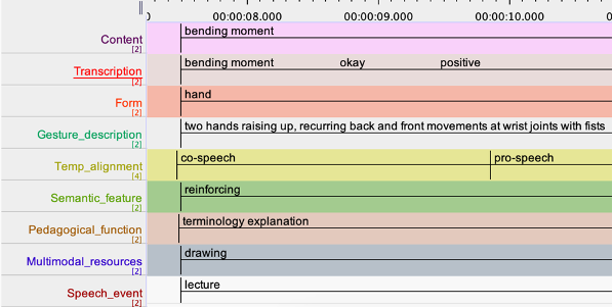The EMI Gesture Corpus (EMIGeCo) is a multimodal subcorpus being developed as part of the English Medium Instruction Corpus (EMIC), designed to capture the embodied and dynamic nature of spoken interaction in English-medium instruction (EMI) classrooms, with a specific focus on gestures as pedagogical resources. In EMI settings, instructors frequently rely on gestures to illustrate abstract ideas, emphasize key points, and manage classroom interaction. These multimodal expressions are not peripheral to content delivery; rather, they are integral to meaning-making. This emphasis on embodied communication aligns with what has been described as the "multimodal turn" in educational research (Jewitt, 2009, p. 4), which emerged as a critique of the dominance of language-centered approaches in higher education. While spoken language continues to be the principal medium for delivering knowledge in academic settings, there has been an increasing integration of multimodal resources including graphs, images, figures, and gestures (Kress, 2010). The multimodal turn calls on scholars to critically engage with these evolving representational practices and to consider the curricular and pedagogical implications they entail (Lim, 2024). Within EMI contexts, this shift underscores the importance of integrating multimodal strategies, particularly gestures, as essential tools for enhancing comprehension in multilingual classrooms.
While recent advances in EMI research have contributed to a deeper understanding of classroom discourse, most existing corpora remain limited to either spoken or written texts (Johnson & Picciuolo, 2022; Simpson-Vlach & Leicher, 2006) and typically rely on transcriptions that overlook the rich multimodal nature of classroom interaction. In contrast, EMIGeCo addresses this gap by integrating multiple modalities, linguistic, visual, aural, gestural, and spatial (Jewitt et al., 2016), to offer a more holistic representation of EMI classroom interaction. EMIGeCo documents naturally occurring classroom events, including lectures, discussions, lab sessions, and problem-solving activities across various disciplines (see also EMIC). It offers a m(a)icro-level perspective of gestural communication, capturing episodes that often include clustered gestures linked with pedagogical purposes.
It includes detailed annotations that capture gesture use in relation to spoken language, including their form, temporal alignment, semantic function, and pedagogical role. The EUDICO Linguistic ANnotator (ELAN) (Max Planck Institute for Psycholinguistics, 2002) is currently being utilized to independently annotate multimodalily in interaction. Each annotated segment, referred to as a Pedagogical Gesture Episode, is treated as a coherent multimodal teaching moment, analyzed both independently and in relation to accompanying verbal discourse. Nine independent tiers were generated in ELAN; (1) the content of the episode, (2) the linguistic transcription, (3) the form of gestures, including details such as hand, head, facial, and body orientation, (4) the holistic description of gestures, (5) the temporal alignment of the gestures (pre-speech, co-speech, and post-speech), (6) their semantic features (e.g., supplementary, reinforcing, or complementary), (7) the pedagogical function of each gesture, categorized based on its role in explanation, feedback, elicitation, or other interactional purposes. Additionally, annotations included (8) their alignment with various multimodal resources (e.g., drawings, videos, slides or diagrams) and (9) the speech event including lectures, lab sessions, etc. in which the gesture episode occurs. This structure facilitated a comprehensive analysis of the multimodal interaction in the EMI classroom context (Figure 1).

Figure 1: ELAN annotation
By embracing a multimodal approach, EMIGeCo offers researchers, educators, and teacher trainers a comprehensive resource to explore how academic content is conveyed through embodied actions in EMI contexts. By bridging language, body, and space, EMIGeCo adds a new dimension to our understanding of EMI discourse and offers valuable insights into how instructors navigate the challenges of teaching complex content in a second language through embodied practices.This sub-corpus contributes to a more nuanced representation of classroom interaction, revealing how gesture, speech and other modes of interaction work together to facilitate understanding in multilingual and multicultural educational settings.
Jewitt, C. (2009). The Routledge Handbook of Multimodal Analysis. London, New York: Routledge.
Jewitt, C., Bezemer, J., & O'Halloran, K. (2016). Introducing Multimodality (1st ed.). Routledge. https://doi.org/10.4324/9781315638027
Johnson, J., & Picciuolo, M. (2022). THE EMIBO CORPUS A resource for investigating lecture discourse across disciplines and lecture modes in an EMI context. Lingue e Linguaggi, 53, 253-272.
Kress, G. (2010). Multimodality: A social semiotic approach to contemporary communication. Abingdon: Routledge.
Lim, F. V. (2024). The multimodal turn in higher education. In Current trends in EMI and multimodality in higher education (pp. 9-25). Routledge.
Max Planck Institute for Psycholinguistics. (2002). http://www.lat-mpi.eu/tools/elan/.
Simpson-Vlach, R. C., & Leicher, S. (2006). The MICASE handbook: A resource for users of the Michigan corpus of academic spoken English. University of Michigan Press.
